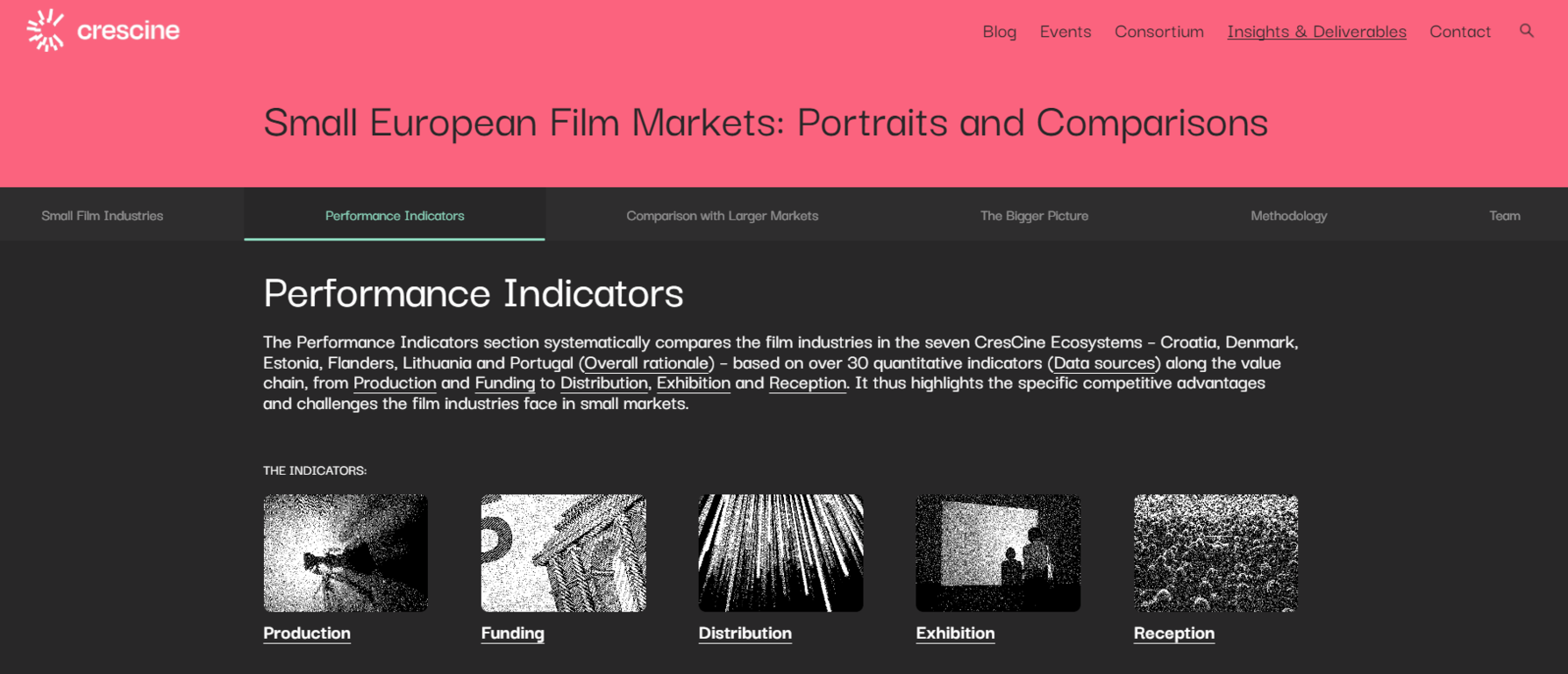Films from small countries like Croatia face strong competition for audiences’ attention, and this competition affects what kinds of films are produced and what is watched in the cinemas. The European research project “CresCine” investigates the strengths and challenges of films in small countries.
Croatia: moderate festival success between a strong incentive program and a weak domestic market
Like Ireland, Croatia has a strong incentive program for service productions, which continuously attracts foreign productions and contributes to the export volume. Comparatively speaking, Croatia has a low level of public film funding, only slightly above Lithuania and Estonia. Available data show that cinema attendance in Croatia is generally low (an average of 0.9 visits per inhabitant), which can partly be attributed to the high price of tickets, but also to the limitations of the screening infrastructure. In the period 2014-2022, the domestic market continuously has low shares in the total attendance (similar to Portugal), but in the last few years an increase can be seen. Croatian films achieve moderate success at international festivals, but are not often screened in cinemas outside the country, while their presence in VoD catalogues has only begun to increase in recent years, notes Jaka Primorac, author of the report for Croatia and coordinator of the CresCine project at IRMO, consortium partner. An interactive portrait of the Croatian film industry is available here.
Investigating the challenges of small film-producing markets in Europe
The research project “CresCine” investigates the challenges faced by small film-producing markets in Europe. Manuel Damásio from Lusófona University in Lisbon leads the project which is funded by the European Union’s Horizon Europe research programme (Grant number: 101094988). The project’s starting point is the economic and cultural significance of local film industries in seven small countries and regions: Ireland, Denmark, Estonia, Lithuania, Portugal, Croatia, and Flanders in Belgium. The project’s new research report, called “Small European Film Markets: Portraits and Comparisons”, tracks their development from 2014 to 2022, considering factors such as production volume, funding patterns, availability in VOD catalogues and admissions.
Seven very different markets during a time of change in the film industry
What all seven markets have in common is a domestic audience too small to sustain a local film industry. What differs are their strategies for addressing this key challenge. Jakob Isak Nielsen from Aarhus University, who has been leading the report explains: “The report results suggest that the industries pursue different forms of orientation – often in combination: cultural ‘resonance’, exports, production service and cinematic art. Each orientation comes with a different form of legitimacy such as national-cultural relevance, foreign sales, job creation and GDP and artistic recognition.”
The choice of markets covered in the project reflects not only different geographical positions but also very different film cultures. The Baltic countries, for example, have seen a huge transformation of their film production and cinema infrastructure after the end of the Soviet Union. Ireland, in particular, but also Croatia, has developed a significant production service economy, attracting foreign productions like The Hitman’s Wife’s Bodyguard (2021) to the country. The report also showcases differences as regards festival recognition. Marius Øfsti from Aarhus University elaborates: “Denmark and Flanders have recently had productions with high critical acclaim and international export like Oscar-winner Another Round (2020) or Close (2022) which won Grand Prix at Cannes.”
The report traces the development of the seven small markets across a period that has seen the expansion of global streaming services, the impact of the COVID-19 pandemic and the economic downturn on film production as well as cinemas. Cathrin Bengesser, also from Aarhus University, explains that although films from small countries are often well represented on local VoD services: “most globally operating streaming services like Netflix do not feature a large choice of films from small markets. This is a problem because the market leaders’ choices affect the diversity of film culture audiences in Europe have easy access to.”
Larger film-producing markets in Europe more strategically oriented towards export
Ivana Kostovska from imec-SMIT-Vrije Universiteit in Brussels has been investigating the export of films from the ‘Big five’ European markets (France, Italy, Germany, Spain and UK) and Poland in key export territories and found that “although France is the strongest exporter of film compared to the other studied EU markets in terms of total number of admissions, films from Ireland and Flanders have achieved higher average admissions shares in US than French films.” The analysis of the export patterns also shows that the large markets we studied typically engage with more diverse production partners compared to most of the small markets. Based on analyses of the ‘Big Five’ markets and Poland, Kostovska and her colleagues Ulrike Rohn and Ana Falcon from Tallinn University conclude that the large markets are much more strategically oriented towards export than most of the small countries.
Films from the USA, however, dominate the European cinematic landscape and Ana Falcon from Tallin University points out that “US films’ strong orientation towards franchises pushes their success in European cinemas. 87 of the top 100 US films in the 13 European markets we studied were based on existing intellectual property.”
Access to the report Small European Film Markets: Portraits and Comparisons
The website https://www.crescine.eu/small-film-industries presents detailed information on the seven small film markets. The report’s core are its 67 interactive data visualizations, offering readers the ability to customize market comparisons and track trends. Jakob Isak Nielsen from Aarhus University explains: “The report is made for professionals from the film industries and policymakers. It allows access to relevant data on film production, distribution, exhibition and reception in one place. It gives the reader the opportunity to easily compare the situation across different markets.” You can delve into portraits of each small film ecosystem. You can jump directly to the key takeaways. You can compare performance indicators across the film production value chain. The website also compares the seven selected small markets to six larger markets, focusing on strategic positioning, film export, VOD catalogues, performance of films on Netflix and festival awards.
More on the research project CresCine
The research project CresCine started in 2023 and will run until 2026. It is funded by the European Union’s Horizon Europe research programme (Grant number: 101094988). The project responded to the European Commission’s Call for Research into the Potential of Cultural and Creative Industries as a Driver of Innovation and Competitiveness in Europe. The project has been awarded 4 million Euros. The consortium consists of 16 research and industry organizations and 10 associated partners in 10 countries. More information on the participating organisations and the project’s output can be found online at www.crescine.eu.



